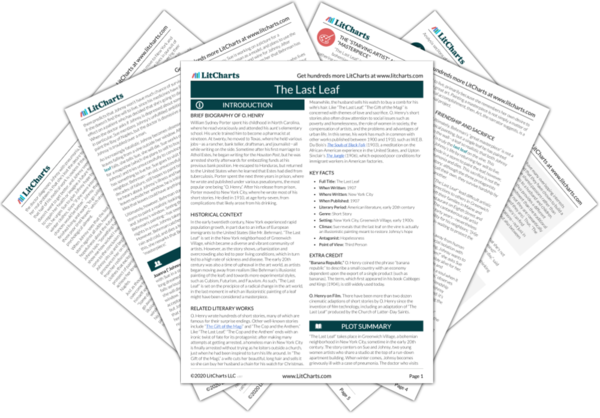As young female artists in early twentieth-century New York, Sue and Johnsy are in an unusual position. Their behavior challenges accepted notions of women’s roles and responsibilities in the period: rather than marrying and devoting their energies to the domestic sphere, they have chosen to move to New York and lead independent but financially precarious lives in pursuit of their art. After meeting at a restaurant and discovering their many shared interests, Sue and Johnsy decide to move in together. Confronted with the disapproval of the wider society, the two women find solace in their friendship.
The story’s few men dismiss and belittle Sue and Johnsy. For example, the doctor who diagnoses Johnsy’s pneumonia asserts that art is not “anything…worth thinking about” for a woman. When he asks if anything is bothering Johnsy, Sue replies that “she wanted to paint the Bay of Naples one day.” The doctor doesn’t believe that this unfulfilled aspiration could be the cause of Johnsy’s depression—“Paint—bosh!” he replies, and asks if she is upset over a man. Sue, by contrast, contradicts the doctor’s view that romantic troubles could be the only thing “worth thinking about” for Johnsy. “Is a man worth—” she begins, but cuts herself off, seeming to imply that a man wouldn’t warrant such a depression. Even other artists who know Sue and Johnsy and seem to respect their work can be dismissive of them based on gender. Their neighbor, Mr. Behrman expresses some of the prevailing views of the time when he shouts “You are just like a woman!” at Sue, accusing her of irrationality and jumping to conclusions.
Some critics have advanced the view that Sue and Johnsy are romantically involved. At the very least, they clearly share a close intimacy that exists outside the more conventional roles for women in the period: they are unmarried, live together, and share a home life that does not involve men or caring for children. Sue seems very sure that Johnsy is not involved in a heterosexual relationship: “There is nothing of that kind,” she tells the doctor. The two women call each other by various endearments including “dear,” “Sudie,” and “dear Johnsy.” Sue is highly loyal to Johnsy, cooking and caring for her and telling her “I’d rather be here by you” when Johnsy asks her to leave. Sue is in despair at the prospect of Johnsy’s death: “Think of me, if you won’t think of yourself,” she says. “What would I do?” O. Henry never conclusively confirms or denies the nature of their relationship, but it’s clear that the two women are very close, and that they are able to support each other’s ambitions and passions when others dismiss them.
“The Last Leaf” thus depicts two women who lead unconventional lives. Whether or not Johnsy and Sue are romantically involved, their decision to build a life together challenges prevailing gender norms, particularly the expectation that early twentieth-century women should devote all their time and efforts to their husband and children. By devoting themselves to each other and to art instead, Johnsy and Sue form a new, alternative model of a family and suggest that women’s interests and abilities are far more varied than most men of the era could understand.
Gender and Sexuality ThemeTracker

Gender and Sexuality Quotes in The Last Leaf
One was from Maine; the other from California. They had met at the table d'hote of an Eighth Street “Delmonico’s,” and found their tastes in art, chicory salad and bishop sleeves so congenial that the joint studio resulted.
[“]Your little lady has made up her mind that she's not going to get well. Has she anything on her mind?”
“She—she wanted to paint the Bay of Naples some day,” said Sue.
“Paint?–bosh! Has she anything on her mind worth thinking about twice—a man for instance?”
[“W]henever my patient begins to count the carriages in her funeral procession I subtract 50 per cent from the curative power of medicines. If you will get her to ask one question about the new winter styles in cloak sleeves I will promise you a one-in-five chance for her, instead of one in ten.”
After the doctor had gone Sue went into the workroom and cried a Japanese napkin to a pulp. Then she swaggered into Johnsy’s room with her drawing board, whistling ragtime… She arranged her board and began a pen-and-ink drawing to illustrate a magazine story. Young artists must pave their way to Art by drawing pictures for magazine stories that young authors write to pave their way to Literature.
“Is dere people in de world mit der foolishness to die because leafs dey drop off from a confounded vine? I haf not heard of such a thing. No, I will not bose as a model for your fool hermit-dunderhead. Vy do you allow dot silly business to come in der brain of her? Ach, dot poor leetle Miss Yohnsy.”
“She is very ill and weak,” said Sue, “and the fever has left her mind morbid and full of strange fancies. Very well, Mr. Behrman, if you do not care to pose for me you needn’t. But I think you are a horrid old—old flibbertigibbet.”
“You are just like a woman!” yelled Behrman. “Who said I will not bose? Go on. I come mit you. For half an hour I haf been trying to say dot I am ready to bose.”
“Dear, dear!” said Sue, leaning her worn face down to the pillow, “think of me, if you won't think of yourself. What would I do?”
But Johnsy did not answer. The lonesomest thing in all the world is a soul when it is making ready to go on its mysterious, far journey. The fancy seemed to possess her more strongly as one by one the ties that bound her to friendship and to earth were loosed.











